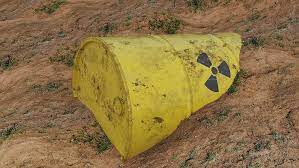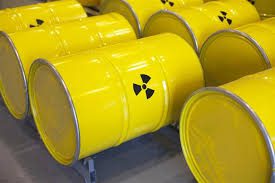Effects of Radioactive Materials
Hiroshima, Nagasaki, Three Mile Island, Chernobyl and Fukushima-Daiichi: these names have become associated with the public‘s fear of radiation, either from use of nuclear weapons or accidents at nuclear power plants.
In fact, people are much more exposed daily to radiation from many other sources, including the atmosphere and the Earth as well as from applications used in medicine and industry. In 1955, nuclear weapon tests raised public concerns about the effects of atomic radiation on air, water and food.
In response, the United Nations General Assembly established the United Nations Scientific Committee on the Effects of Atomic Radiation (UNSCEAR) to collect and evaluate information on the levels and effects of radiation exposure.
Before going into more detail about the effects of radiation exposure, we should recall the pioneers in radiation science introduced earlier. Soon after Henri Becquerel‘s discovery, he himself experienced the most troublesome drawback of radiation the effect it can have on living tissues.
A vial of radium that he had put in his pocket damaged his skin. Wilhelm Conrad Roentgen, who discovered X-rays in 1895, died of cancer of the intestine in 1923. Marie Curie, who was also exposed to radiation throughout her working life, died of a blood disease in 1934.
It is reported that by the end of the 1950s, at least 359 early radiation workers (mainly doctors and other scientists) had died from their exposure to radiation, unaware of the need for protection.
With the growing awareness of the risks associated with exposure to radiation, the twentieth century witnessed the development of intensive research on the effects of radiation on humans and the environment.
The most important evaluation of population groups exposed to radiation is the study of approximately 86 500 survivors of the atomic bombings of Hiroshima and Nagasaki at the end of the Second World War in 1945 (henceforth referred to as the survivors of the atomic bombings).
Further, reliable data on the subject comes from experience with irradiated patients, and with workers after accidental exposure (e.g. Chernobyl nuclear power plant accident), and from animal and cell experiments in laboratories.
Effects of Radioactive Materials on Human Health
Since the discovery of radiation, more than a century of radiation research has yielded extensive information on the biological mechanisms by which radiation can affect health.
It is known that radiation can produce effects at the level of cells, causing their death or modification usually because of direct damage to deoxyribonucleic acid (DNA) strands in a chromosome. If the number of damaged or killed cells is large enough, it may result in organ dysfunction and even death.
Also, other damage to DNA may occur that does not kill the cell. Such damage is usually repaired completely but if not, the resulting modification known as cell mutation will be reflected in subsequent cell divisions and may ultimately lead to cancer.
If the cells modified are those transmitting hereditary information to descendants, genetic disorders may arise.
Information on biological mechanisms and on heritable effects is often gained from laboratory experiments.
On the basis of the observation of their occurrence, health effects following radiation exposure are defined here as either early or delayed health effects.
Generally, early health effects are evident through diagnosis of clinical syndromes in individuals, and delayed health effects such as cancer through epidemiological studies by observation of increased occurrence of a pathology in a population.
Further, special attention is paid here to effects on children and on embryos/fetuses, and to heritable effects.
Early health effects
Early health effects are caused by extensive cell death/damage. Examples are skin burns, loss of hair and impairment of fertility.
These health effects are characterized by a relatively high threshold that must be exceeded over a short period before the effect occurs. The severity of the effect increases with increasing dose after the threshold has been exceeded.
Generally, acute doses higher than 50Gy (Gray, unit of absorbed dose) damage the central nervous system so badly that death occurs within a few days.
Even at doses lower than 8Gy, people show symptoms of radiation sickness also known as acute radiation syndrome, which could include nausea, vomiting, diarrhoea, intestinal cramps, salivation, dehydration, fatigue, apathy, listlessness, sweating, fever, headache and low blood pressure.
Read Also : Complete List of Recyclable Plastics
The term acute refers to medical problems that occur directly after exposure rather than ones that develop after a prolonged period.
However, victims may survive at first only to die from gastrointestinal damage one to two weeks later. Lower doses may not inflict gastrointestinal injury but still cause death after a few months, mainly from damage to the red bone marrow.
Still lower doses will delay the onset of sickness and produce less severe symptoms. About half of those who receive doses of 2Gy suffer from vomiting after about three hours, but this is rare for doses below 1Gy.
Fortunately, if the red bone marrow and the rest of the blood-forming system receive less than 1Gy, they have a remarkable capacity for regeneration and can completely recover although there will be a higher risk of developing leukaemia in later years.
If only part of the body is irradiated, enough bone marrow will normally survive unimpaired to replace what has been damaged. Animal experiments suggest that even if only a tenth of the active bone marrow escapes irradiation, the chances of survival are nearly 100 per cent.
The fact that radiation can directly damage cell DNA is applied to deliberately kill malignant cells with radiation in cancer treatment known as radiotherapy.

The total amount of radiation applied in radiotherapy varies depending on the type and stage of cancer being treated. Typical doses for solid tumour treatments range from 20 to 80 Gy to the tumour, which would endanger the patient if delivered as a single dose.
Thus, in order to control the treatment, radiation doses are applied in repeated fractions of maximally 2 Gy. This fractionation allows cells of normal tissue to recover, while tumour cells are killed because they are generally less efficient at repairing after radiation exposure.
Delayed health effects
Delayed health effects occur a long time after exposure. In general, most delayed health effects are also stochastic effects, i.e. for which the probability of occurrence depends on the radiation dose received.
These health effects are believed to be caused by modifications in the genetic material of a cell following radiation exposure.
Examples of delayed effects are solid tumours and leukaemia occurring in exposed persons and genetic disorders occurring in the offspring of persons who were exposed to radiation.
The frequency of occurrence but not the severity of these effects in a population appears to increase with larger doses.
Epidemiological studies are of great importance in understanding delayed health effects after radiation exposure. Such studies use statistical methods to compare the occurrence of a health effect (e.g. cancer) in an exposed population with that in an unexposed population.
If a considerable increase is found in the exposed population, it may be that it is associated with the radiation exposure for the population as a whole.
The most important long-term evaluation of populations exposed to radiation is the epidemiological study of the survivors of the atomic bombings.
This is the most comprehensive study ever conducted becauseof the large number of people, essentially representative of the general population, receiving a wide variety of doses spread fairly evenly over the body. Estimates of the doses received by this group are also relatively well known.
So far, the study has revealed a few hundred more cancer cases than would be expected in this group if they had not been exposed to radiation. Because many of the survivors of the atomic bombings are still alive, studies are continuing in order to complete the evaluation.
Cancer
Cancer is responsible for about 20 per cent of all fatalities and is the most common cause of death in industrialized countries after cardiovascular disease.
About four out of ten persons in the general population are expected to develop cancer during their lifetime even in the absence of radiation exposure. In recent years, the most common cancers among men have been lung, prostate, colorectum, stomach, and liver cancer and among women they have been breast, colorectum, lung, cervix, and stomach cancer.
The development of a cancer is a complex process, consisting of a number of stages. An initiating phenomenon, most probably affecting a single cell, appears to start the process, but a series of other events seem to be necessary before the cell becomes malignant and the tumour develops.
Cancer becomes evident only long after the first damage is done, following a period of latency.
The probability of cancer occurring following radiation exposure is a major concern and could be calculated for a group if it were exposed to a sufficiently high level of radiation to cause an increased occurrence of cancer that would overcome the statistical and other uncertainties.
However, the real contribution of radiation as a cause of cancer remains unknown.
Leukaemia, thyroid cancer and bone cancer first appear within a few years of exposure to radiation, while most other cancers are not expressed until at least 10 years, often several decades, after exposure.
However, no single type of cancer is uniquely caused by exposure to radiation so it is impossible to distinguish radiation-induced tumours from those arising from many other causes.
Nevertheless, it is important to estimate the probability of getting cancer after certain doses of radiation in order to provide a sound scientific basis for setting exposure limits.
Other health effects
High radiation doses to the heart increase the probability of cardiovascular diseases (e.g. heart attacks). Such exposure may happen during radiotherapy, although treatment techniques nowadays result in lower cardiac doses.
However, there is no existing scientific evidence to conclude that exposure to low doses of radiation causes cardiovascular diseases.
UNSCEAR recognized that there was an increased occurrence of cataracts among Chernobyl emergency workers, possibly associated with high doses of radiation.
Further, UNSCEAR has also studied the effects of radiation on the human immune system in survivors of the atomic bombings, in emergency workers at the Chernobyl nuclear power plant and in patients undergoing radiotherapy treatment.
The effects of radiation on the immune system are assessed by estimating changes in cell numbers or by using a variety of functional analyses. High doses of radiation suppress the immune system mainly because of damage to lymphocytes.
Their reduction is currently used as an early indicator to determine the radiation dose after acute exposure.
Effects on offspring
If radiation damage occurs in reproductive cells, the sperm or ovum, it can lead to heritable effects in descendants. Moreover, radiation can directly damage an embryo or fetus already developing within the womb.
It is important to distinguish between radiation exposure of adults, children and embryos/fetuses. UNSCEAR has conducted comprehensive reviews of health effects, including heritable effects, in these groups.
Effects on children
Health effects in humans depend upon a number of physical factors. Because of their anatomical and physiological differences, the impacts of radiation exposure on children and on adults are different.
Further, because children have smaller bodies and are less shielded by overlying tissues, the dose to their internal organs will be higher than that for adults for a given external exposure. Also, children are shorter than adults, so they may receive higher doses from radionuclides deposited on the ground.
Regarding internal exposure, because of the smaller size of children, and because their organs are, thus, closer together, radionuclides concentrated in one organ irradiate other organs more than would be the case for adults.
There are also many other age-related factors involving metabolism and physiology that make a substantial difference in dose at different ages. Several radionuclides are of particular concern regarding internal exposure of children.
Accidents involving releases of radioactive iodine-131 can be significant sources of exposure of the thyroid. For a given intake, the dose to the thyroid for infants is about nine times higher than that for adults. Studies of the Chernobyl nuclear power plant accident have confirmed the link between thyroid cancer and iodine-131, which concentrates mainly in this organ.
Epidemiological studies have shown that young people under 20 years of age appear to be about twice as likely as adults to develop leukaemia following the same radiation exposure.
Further, children under 10 years are particularly susceptible; some other studies suggest that they are three to four times more likely to die of leukaemia than adults.
Other studies have also shown that girls exposed at under 20 years of age are about twice as likely to develop breast cancer as adult women.
Children are more likely than adults to develop cancer after radiation exposure, but it may not emerge until later in life when they reach an age at which the cancer normally becomes evident.
Effects on the unbornchild
An embryo or fetus can be exposed through radioactive material transferred by the mother via food and drink (internal exposure) or directly through external exposure. Because a fetus is protected in the uterus, its radiation dose tends to be lower than the dose to its mother for most radiation exposure events.
However, the embryo and fetus are particularly sensitive to radiation, and the health consequences of exposure can be severe, even at radiation doses lower than those that immediately affect the mother. Such consequences can include growth retardation, malformations, impaired brain function and cancer.
Effects on Animals and Plants
Effects of radiation exposure on animals and plants are receiving more attention than previously. In past decades, the prevailing view was that if human life were adequately protected, both plants and animals would be similarly protected.
UNSCEAR evaluated the effects of radiation exposure on plants and animals and found that a theoretical dose range of 1–10 Gy was unlikely to result in effects on animal and plant populations and that individual responses to radiation exposure varied (mammals are the most sensitive of all animals).
Those effects that are likely to be significant at the population level concern fertility, mortality and the induction of mutations. Reproductive changes, such as in the numbers of offspring, are a more sensitive indicator of radiation effects than mortality.
Lethal doses represent doses at which 50 per cent of the exposed subjects would die. For plants exposed in a relatively short time (acute), these have been noted to range from less than 10 to about 1000 Gy. In general, larger plants are more radiosensitive than smaller ones.
Lethal doses range from 6 to 10 Gy for small mammals and are about 2.5 Gy for larger ones. Some insects, bacteria and viruses can tolerate doses of over 1000 Gy.
In summary, epidemiological studies have shown that young people under 20 years of age appear to be about twice as likely as adults to develop leukaemia following the same radiation exposure.
Leukaemia, thyroid cancer and bone cancer first appear within a few years of exposure to radiation, while most other cancers are not expressed until at least 10 years, often several decades.
Read Also ; Industrial Wastewater Treatment Process
High radiation doses to the heart increase the probability of cardiovascular diseases (e.g. heart attacks).
Since the discovery of radiation, more than a century of radiation research has yielded extensive information on the biological mechanisms by which radiation can affect health.
If radiation damage occurs in reproductive cells, the sperm or ovum, it can lead to heritable effects in descendants.



